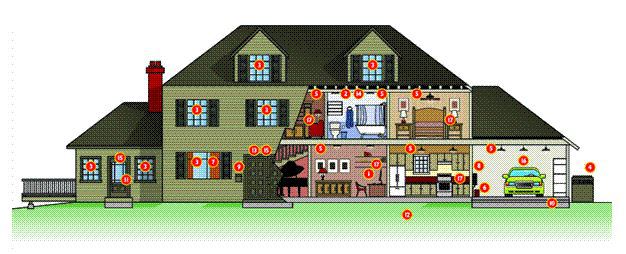1 Ambient Intelligence Agency (Aml) Control, 2 Light Sensor, 3 Windows and Door Control, 4 HVAC, 5 Lighting Control, 6Automatic Pet Feeder, 7 Motorized Drapes, 8 Automatic Watering, 9 Mailbox Sensor, 10 Driveway Sensor, 11 Security System, 12 Lawn Moisture Sensor, 13 Face Recognition Sensor, 14 Motion Sensors, 15 Door Sensors, 16 Aml Interface with Car, 17 Aml Lighting with Smartphone Lighting Control
Credit: Courtesy Washington State University
[Article] – For decades, builders have talked about making homes “smarter.” Lately, that’s meant installing systems that monitor energy usage to help homeowners reduce their utility bills. But what if a house could “think” for itself by responding, via sensors and computers, to an owner’s behavioral patterns and adjust the indoor environment accordingly?
For the past year, Diane Cook, an engineering professor at Washington State University, has been evaluating the limits of “ambient intelligence” (AI) at a retirement home in Seattle, where her team has installed sensors that detect motion and track energy use in residents’ apartments. Computers interpret these “observations” and make decisions about, for example, when to raise or lower the heat.
The ability to assess information and act by automating the control of devices and appliances goes well beyond what houses are capable of today. But Cook’s team has created “fairly robust models” for such a house, and she can envision a day when homeowners go to their local home improvement store to purchase sensor kits they install themselves. (A 2,000-square-foot apartment at the retirement home costs about $2,000 to rig with wireless sensors and software, she says.)
Cook, whose background is in “machine learning” and data mining, got interested in home automation 10 years ago when she and her in-laws, who are home builders, toured the “Home of the Future” at the Texas State Fair. Cook recalls that what she thought was missing from the concept was “intelligence” transmitted from devices in the home that could be collected to determine occupant behavior and refine the house’s “operations.”
Cook doesn’t think residents would need to wear sensors for optimal readings (although data mining gets harder when a room has more than one person in it). She thinks that energy monitoring systems are “a good first step” to get homeowners comfortable with the technology. (Bosch and Cisco have provided some of the funding for her research.) And Cook told the Ars Technica technology website that a homeowner’s smartphone could serve as a data-gathering tool for the in-home AI system.
Cook’s ultimate vision for AI is to detect changes in occupant behavior that indicate cognitive or physical deterioration. If the house could adjust to such impairments and provide warnings to family members, the afflicted person might be able to age in place longer.

